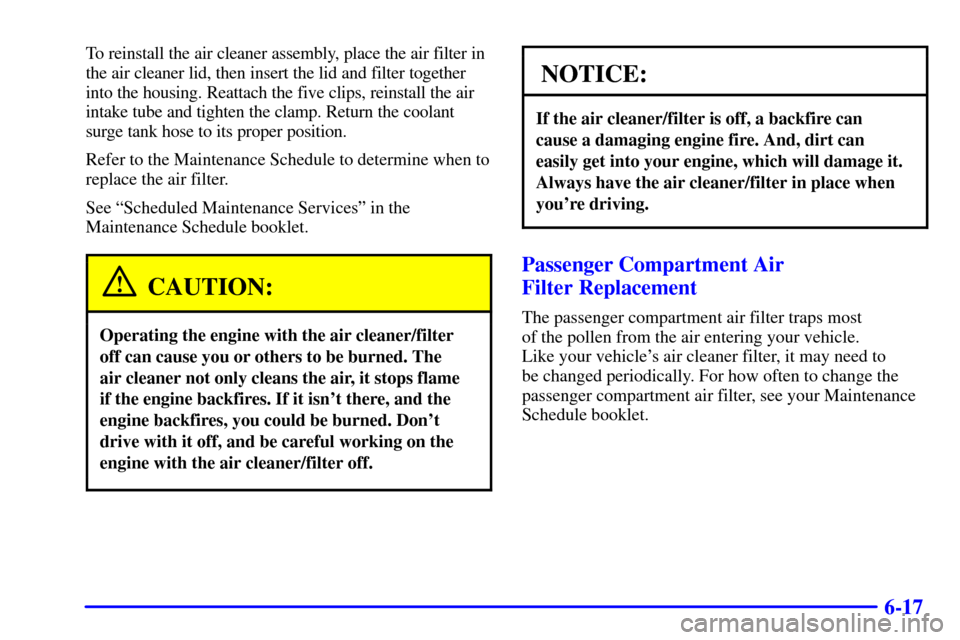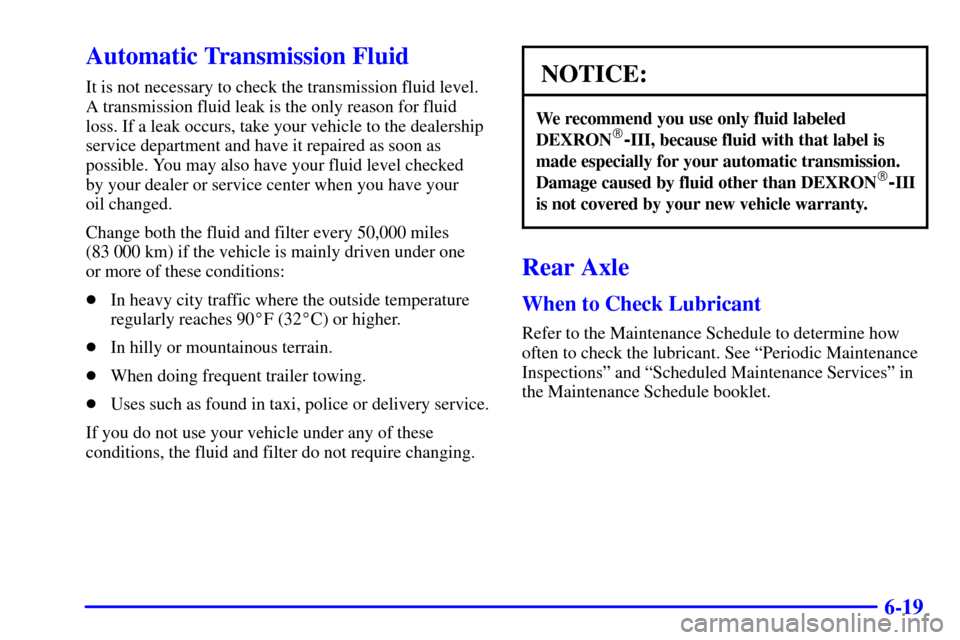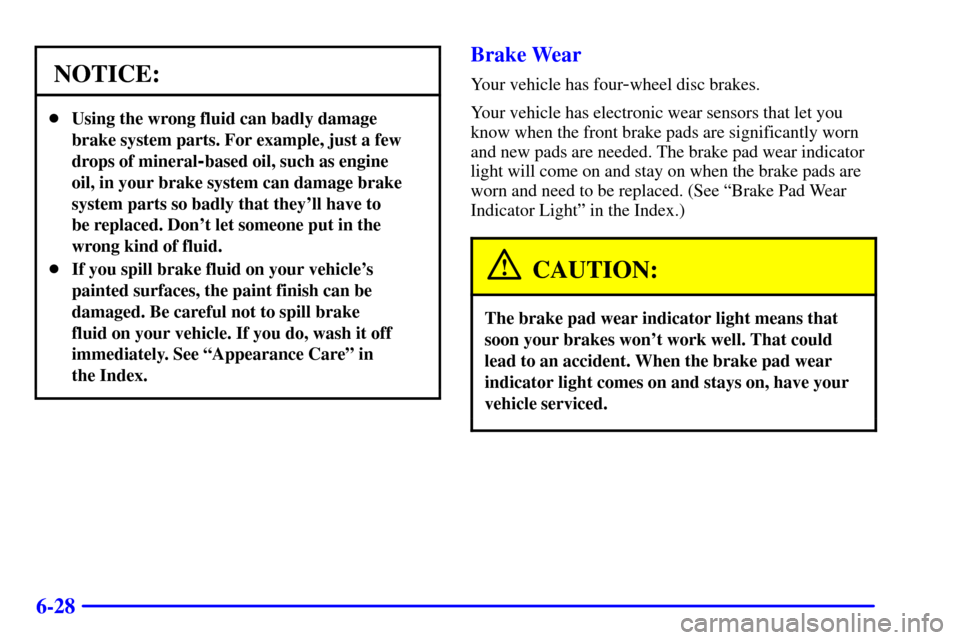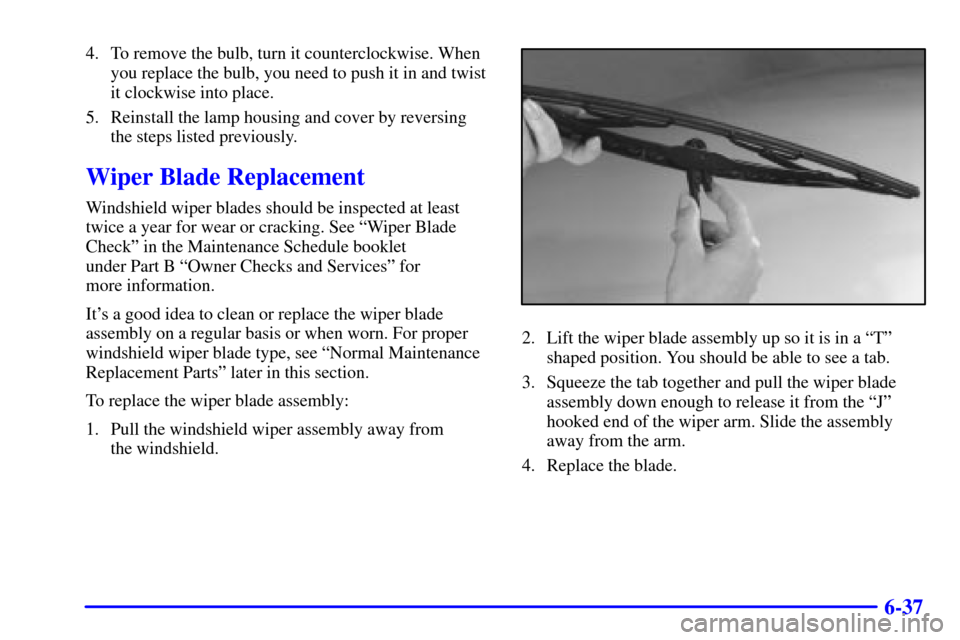Page 261 of 321

6-17
To reinstall the air cleaner assembly, place the air filter in
the air cleaner lid, then insert the lid and filter together
into the housing. Reattach the five clips, reinstall the air
intake tube and tighten the clamp. Return the coolant
surge tank hose to its proper position.
Refer to the Maintenance Schedule to determine when to
replace the air filter.
See ªScheduled Maintenance Servicesº in the
Maintenance Schedule booklet.
CAUTION:
Operating the engine with the air cleaner/filter
off can cause you or others to be burned. The
air cleaner not only cleans the air, it stops flame
if the engine backfires. If it isn't there, and the
engine backfires, you could be burned. Don't
drive with it off, and be careful working on the
engine with the air cleaner/filter off.
NOTICE:
If the air cleaner/filter is off, a backfire can
cause a damaging engine fire. And, dirt can
easily get into your engine, which will damage it.
Always have the air cleaner/filter in place when
you're driving.
Passenger Compartment Air
Filter Replacement
The passenger compartment air filter traps most
of the pollen from the air entering your vehicle.
Like your vehicle's air cleaner filter, it may need to
be changed periodically. For how often to change the
passenger compartment air filter, see your Maintenance
Schedule booklet.
Page 263 of 321

6-19
Automatic Transmission Fluid
It is not necessary to check the transmission fluid level.
A transmission fluid leak is the only reason for fluid
loss. If a leak occurs, take your vehicle to the dealership
service department and have it repaired as soon as
possible. You may also have your fluid level checked
by your dealer or service center when you have your
oil changed.
Change both the fluid and filter every 50,000 miles
(83 000 km) if the vehicle is mainly driven under one
or more of these conditions:
�In heavy city traffic where the outside temperature
regularly reaches 90�F (32�C) or higher.
�In hilly or mountainous terrain.
�When doing frequent trailer towing.
�Uses such as found in taxi, police or delivery service.
If you do not use your vehicle under any of these
conditions, the fluid and filter do not require changing.NOTICE:
We recommend you use only fluid labeled
DEXRON�-III, because fluid with that label is
made especially for your automatic transmission.
Damage caused by fluid other than DEXRON
�-III
is not covered by your new vehicle warranty.
Rear Axle
When to Check Lubricant
Refer to the Maintenance Schedule to determine how
often to check the lubricant. See ªPeriodic Maintenance
Inspectionsº and ªScheduled Maintenance Servicesº in
the Maintenance Schedule booklet.
Page 272 of 321

6-28
NOTICE:
�Using the wrong fluid can badly damage
brake system parts. For example, just a few
drops of mineral
-based oil, such as engine
oil, in your brake system can damage brake
system parts so badly that they'll have to
be replaced. Don't let someone put in the
wrong kind of fluid.
�If you spill brake fluid on your vehicle's
painted surfaces, the paint finish can be
damaged. Be careful not to spill brake
fluid on your vehicle. If you do, wash it off
immediately. See ªAppearance Careº in
the Index.
Brake Wear
Your vehicle has four-wheel disc brakes.
Your vehicle has electronic wear sensors that let you
know when the front brake pads are significantly worn
and new pads are needed. The brake pad wear indicator
light will come on and stay on when the brake pads are
worn and need to be replaced. (See ªBrake Pad Wear
Indicator Lightº in the Index.)
CAUTION:
The brake pad wear indicator light means that
soon your brakes won't work well. That could
lead to an accident. When the brake pad wear
indicator light comes on and stays on, have your
vehicle serviced.
Page 274 of 321

6-30
Battery
Your new vehicle comes with a maintenance free
ACDelco� battery. When it's time for a new battery,
get one that has the replacement number shown on
the original battery's label. We recommend an
ACDelco battery.
CAUTION:
Batteries have acid that can burn you and gas
that can explode. You can be badly hurt if you
aren't careful. See ªJump Startingº in the Index
for tips on working around a battery without
getting hurt.
After a power loss, such as disconnecting the battery
or removing the maxi fuses in the power distribution
fuse block, the following steps must be performed to
calibrate the Electronic Throttle Control. If this is not
done, the engine will not run properly.1. Turn the ignition key to the ON (II) position. Do not
start the engine.
2. Leave the ignition in the ON (II) position for at least
three minutes so that the electronic throttle control
will cycle and re
-learn its home position.
3. Turn the ignition to OFF.
4. Start and run the engine for at least 30 seconds.
Also, for your audio system, see ªTheft
-Deterrent
Featureº in the Index.
To reprogram your power windows and sunroof
(if equipped), see ªPower Windowsº and ªSunroofº
in the Index.
Bulb Replacement
For any bulb changing procedure not listed in this
section, contact your dealer service department.
For bulb types, see ªReplacement Bulbsº in the Index.
Page 275 of 321
6-31 High Intensity Discharge (HID) Lighting
(If Equipped)
CAUTION:
The low beam High Intensity Discharge lighting
system operates at a very high voltage. If you
try to service any of the system components,
you could be seriously injured. Have your dealer
or a qualified technician service them.
Halogen Bulbs
CAUTION:
Halogen bulbs have pressurized gas inside and
can burst if you drop or scratch the bulb. You or
others could be injured. Be sure to read and
follow the instructions on the bulb package.
Headlamps
1. With a screwdriver, unscrew the fastener on the
headlamp cover and then remove the cover to gain
access to the headlamps. Note that the inner bulb is
for the high
-beam headlamp and the outer bulb is for
the low
-beam headlamp.
Page 278 of 321
6-34
Headlamp Aiming
If your vehicle is damaged in an accident, the headlamp
aim may be affected. Aim adjustment to the low beam
may be necessary if it is difficult to see lane markers
(for horizontal aim), or if oncoming drivers flash their
high beams at you (for vertical aim). If you believe your
headlamps need to be re
-aimed, we recommend that you
take your vehicle to the dealer for service. However, it is
possible for you to re
-aim your headlamps by following
the procedure in the service manual for your vehicle.
NOTICE:
To make sure your headlamps are aimed properly,
read all the instructions before beginning. Failure
to follow these instructions could cause damage to
headlamp parts.
Front Turn Signal Lamp
1. With a screwdriver, unscrew the fastener on the
headlamp cover and then remove it to access the turn
signal lamps.
Page 281 of 321

6-37
4. To remove the bulb, turn it counterclockwise. When
you replace the bulb, you need to push it in and twist
it clockwise into place.
5. Reinstall the lamp housing and cover by reversing
the steps listed previously.
Wiper Blade Replacement
Windshield wiper blades should be inspected at least
twice a year for wear or cracking. See ªWiper Blade
Checkº in the Maintenance Schedule booklet
under Part B ªOwner Checks and Servicesº for
more information.
It's a good idea to clean or replace the wiper blade
assembly on a regular basis or when worn. For proper
windshield wiper blade type, see ªNormal Maintenance
Replacement Partsº later in this section.
To replace the wiper blade assembly:
1. Pull the windshield wiper assembly away from
the windshield.
2. Lift the wiper blade assembly up so it is in a ªTº
shaped position. You should be able to see a tab.
3. Squeeze the tab together and pull the wiper blade
assembly down enough to release it from the ªJº
hooked end of the wiper arm. Slide the assembly
away from the arm.
4. Replace the blade.
Page 282 of 321
6-38
5. To reinstall the wiper blade assembly, slide it over
the wiper arm to engage the ªJº hooked end on the
wiper blade assembly. Pull up on the assembly to
lock it into place.
Tires
Your new vehicle comes with high-quality tires made by
a leading tire manufacturer. If you ever have questions
about your tire warranty and where to obtain service,
see your Catera Warranty booklet for details.
CAUTION:
Poorly maintained and improperly used tires
are dangerous.
�Overloading your tires can cause overheating
as a result of too much friction. You could
have an air
-out and a serious accident.
See ªLoading Your Vehicleº in the Index.
�Underinflated tires pose the same danger
as overloaded tires. The resulting accident
could cause serious injury. Check all tires
frequently to maintain the recommended
pressure. Tire pressure should be checked
when your tires are cold.
CAUTION: (Continued)